脊髓损伤后脊髓回路及功能的恢复与重组
脊髓损伤后的康复护理

脊髓损伤后的康复护理脊髓损伤是由于各种不同致病因素引起的脊髓结构、功能的损害,造成损伤水平以下运动、感觉、自主功能改变,导致相应的功能障碍.根据致病因素不同可分为外伤性脊髓损伤和非外伤性脊髓损伤。
脊髓损伤主要是因直接暴力(砸伤、摔伤、刺伤、枪伤等)造成脊柱过度屈曲骨折、脱位伤及脊神经,其次是因脊髓感染、变性、肿瘤侵及脊髓因损伤水平和程度差异,可见损伤水平以下躯干、肢体、皮肤感觉、运动反射完全消失、大小便失禁等症状。
脊髓损伤多造成严重瘫痪致残,胸、腰髓损伤引起双下肢和躯干的全部或部分瘫痪称截瘫,颈脊髓以上损伤,上肢受累则称四肢瘫。
据统计,我国SCI原因主要是高处坠落、砸伤、交通事故等。
一、主要功能障碍脊髓损伤因损伤部位、损伤程度不同,引起的功能障碍也不同。
常见的功能障碍有运动功能障碍、感觉障碍、括约肌功能障碍、自主神经功能障碍等。
部分患者常有并发症,出现深静脉血栓形成、疼痛、异位骨化、压疮、关节挛缩等。
二、康复工作内容脊髓损伤急性期的康复治疗目的是抢救患者生命,预防及减少脊髓功能丧失,预防及治疗并发症,应用各种方法最大限度地利用残存的功能,最大限度使患者重新开始自理、创造性的生活。
其康复治疗手段有入院前处理与院后急救、外科手术治疗、药物治疗、康复护理、康复训练、呼吸保障。
脊髓损伤恢复期的康复治疗目的是为了让患者适应新的生活,提高患者的生活自理能力,能够借助轮椅独立或步行。
其康复治疗手段有肌力训练、肌肉牵张训练、坐位及平衡训练、体位转移训练、轮椅训练、站立和行走训练、日常生活活动能力的训练、生物反馈疗法等。
三、康复护理措施(一)配合抢救配合医生现场抢救时,必须持续固定脊柱,保持脊柱的稳定性,同时确保呼吸道通畅,必要时吸痰,防止窒息.保持静脉通道通畅,严密观察患者的神智、呼吸、心率、血压等病情变化,及时向医生汇报。
(二)尽早开始治疗脊髓损伤后早期(即伤后6~12小时)的改变往往局限于中央灰质,而白质尚无明显改变。
脊髓损伤的神经重建与功能恢复
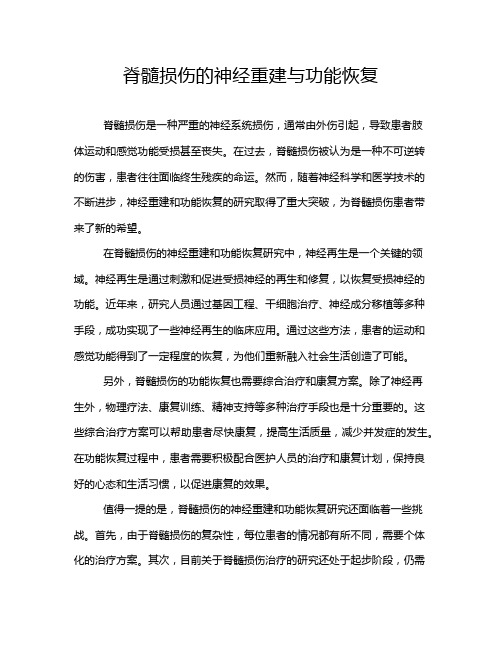
脊髓损伤的神经重建与功能恢复脊髓损伤是一种严重的神经系统损伤,通常由外伤引起,导致患者肢体运动和感觉功能受损甚至丧失。
在过去,脊髓损伤被认为是一种不可逆转的伤害,患者往往面临终生残疾的命运。
然而,随着神经科学和医学技术的不断进步,神经重建和功能恢复的研究取得了重大突破,为脊髓损伤患者带来了新的希望。
在脊髓损伤的神经重建和功能恢复研究中,神经再生是一个关键的领域。
神经再生是通过刺激和促进受损神经的再生和修复,以恢复受损神经的功能。
近年来,研究人员通过基因工程、干细胞治疗、神经成分移植等多种手段,成功实现了一些神经再生的临床应用。
通过这些方法,患者的运动和感觉功能得到了一定程度的恢复,为他们重新融入社会生活创造了可能。
另外,脊髓损伤的功能恢复也需要综合治疗和康复方案。
除了神经再生外,物理疗法、康复训练、精神支持等多种治疗手段也是十分重要的。
这些综合治疗方案可以帮助患者尽快康复,提高生活质量,减少并发症的发生。
在功能恢复过程中,患者需要积极配合医护人员的治疗和康复计划,保持良好的心态和生活习惯,以促进康复的效果。
值得一提的是,脊髓损伤的神经重建和功能恢复研究还面临着一些挑战。
首先,由于脊髓损伤的复杂性,每位患者的情况都有所不同,需要个体化的治疗方案。
其次,目前关于脊髓损伤治疗的研究还处于起步阶段,仍需进一步的基础研究和临床实践。
此外,一些治疗手段的安全性和有效性也尚有争议,需要更多的数据支持和验证。
梳理一下本文的重点,我们可以发现,是一项重要且具有挑战性的研究领域。
通过神经再生、综合治疗和康复方案的综合应用,能够为脊髓损伤患者带来新的希望和机会。
在未来的研究中,我们需要不断探索新的治疗方法和策略,促进脊髓损伤患者的康复和生活质量的提高。
希望通过我们的努力,能够为脊髓损伤患者带来更多的福音和希望。
脊髓损伤恢复期的康复治疗(常见疾病康复课件)

脊髓损伤的康复治疗
(二)康复训练——恢复期康复治疗
➢ 肌力和耐力增强训练 ➢ 轮椅操纵训练 ➢ 上肢支具、辅助具应用训练(T1以上损伤患者) ➢ 下肢支具应用训练(T2以下损伤患者) ➢ 治疗性站立、步行训练(T2~T12损伤患者) ➢ 功能性步行训练(L1~L5损伤患者)
脊髓损伤的康复治疗
(二)康复训练——恢复期康复治疗
L3~L4 L5~S1
S2
应用短下肢支具(AFO)及肘杖进行社区功能性步行 应用足托及手杖进行社区步行 社区步行
脊髓损伤的康复治疗 (二)康复训练——恢复期康复治疗
摆至步
摆过步
脊髓损伤的康复治疗 (二)康复训练——恢复期康复治疗
四点步
两点步
不同脊髓损伤水平患者站立及行走的训练内容
损伤水平
康复训练内容
C2~C4 起立床站立
C5~C8 平行杠内治疗性站立
T1~T5 应用骨盆带长下肢支具(HKAFO)及腋杖进行支具站立训练
T6~T10 应用骨盆带长下肢支具(HKAFO)及腋杖进行治疗性步行
T11~T12 应用长下肢支具(KAFO)及腋杖进行治疗性步行 L1 应用长下肢支具(KAFO)及腋杖进行家庭功能性步行 L2 应用长下肢支具(KAFO)及腋杖进行家庭或社区功能性步行
脊髓损伤恢复期的康复治疗
目录/contents
01 恢复期定义及康复目标
0目标 恢复期康复治疗当患者生命体征稳定、脊柱稳固性好,并
能够离床坐在轮椅上2小时及以上时,即可开始恢复期的康复。 从急性稳定期(轮椅活动期)开始,康复训练进入全面进行阶段。 康复目标为最大程度恢复患者的功能,借助一切可能的康复手 段提高患者日常生活能力和工作能力,为配合患者回归家庭、重 返社会做好准备。
07-脊髓损伤的修复与再生
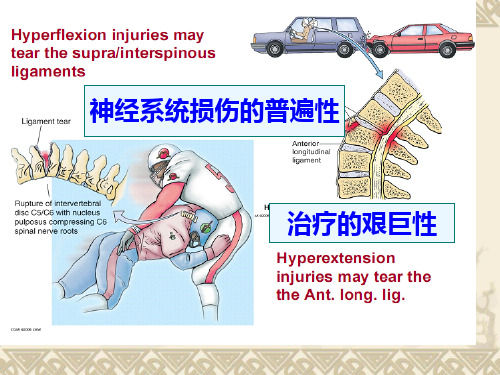
主要内容
一、神经损伤后胞体和轴突的反应 二、脊髓继发性损伤的机制 三、脊髓损伤模型 四、实验性脊髓损伤的观察评定方法 五、影响脊髓损伤后神经再生的因素 六、脊髓损伤的内源性保护性因子
七、脊髓损伤的治疗策略
八、脊髓损伤修复的实验研究
COLLEGE BASIC MEDICAL SCIENCES COLLEGE OF BASIC BASICMEDICAL MEDICALSCIENCES SCIENCES COLLEGE OF THIRD MILITARY MILITARY THIRD MEDICAL UNIVERSITY MILITARYMEDICAL MEDICALUNIVERSITY UNIVERSITY
全球不同的国家,脊髓损伤的年
发病率为15/100万-40/100万。
美国每年约有1万例新的SCI患者 我国上海SCI的年发生率约为
13.7/100万以上。
脊髓损伤(spinal cord injury,SCI)基础研 究主要集中在三个方面:
(1)脊髓损伤后脊髓内继发病理改变的预防
和逆转。
ቤተ መጻሕፍቲ ባይዱ
(2)脊髓损伤后功能受损但结构完整的神经
(5)继发性CNS损伤(Secondary injury)
半影区(Penumbra zone)
半影区 Centre Region
COLLEGE BASIC MEDICAL SCIENCES COLLEGE OF BASIC BASICMEDICAL MEDICALSCIENCES SCIENCES COLLEGE OF THIRD MILITARY MILITARY THIRD MEDICAL UNIVERSITY MILITARYMEDICAL MEDICALUNIVERSITY UNIVERSITY
关于脊髓损伤者的日常康复训练

脊髓损伤者的日常康复训练包括多个方面,主要可以分为急性期和恢复期两个阶段。
以下是一些具体的训练内容:在急性期,主要目标是预防并发症,并尽可能地恢复一些基本功能。
具体训练内容包括:1. 正确的体位摆放,这可以预防关节僵硬和肌肉萎缩。
2. 对全身关节进行被动活动,这可以防止关节僵硬。
3. 对残存肌力及损伤平面以上的肌肉进行肌力增强和耐力训练。
4. 重视呼吸排痰训练和间歇导尿膀胱训练,以预防肺部感染和泌尿系统感染。
5. 预防压疮、深静脉血栓形成等并发症的发生。
在恢复期,主要目标是促进患者更大程度的功能恢复。
具体训练内容包括:1. 关节活动度和肌力被动训练,主动肌力训练,疼痛治疗,膀胱训练与直肠管理,呼吸和排痰训练。
2. 通过减重平板步行训练和机器人步态训练改善患者的步行和移动能力,增强下肢肌力。
3. 进行呼吸训练,包括吸气肌力量训练,以提高肺活量、最大随意通气、最大呼气压和最大吸气压。
4. 进行平衡和协调训练,坐姿平衡练习、站立平衡练习、步态训练等,以增强肌肉协调性和增加身体的稳定性。
5. 进行柔韧性和伸展训练,帮助改善关节的灵活性,缓解肌肉紧张和痉挛,促进身体的活动范围。
6. 进行功能性训练,如穿衣、洗澡、梳头等日常生活动作训练,以逐渐恢复独立生活所需的功能。
7. 进行并发症预防,如预防骨质疏松等。
此外,日常的肌肉锻炼也是非常重要的,可以通过传统的肌肉力量锻炼如举重、屈伸等来进行,也可以使用电刺激来促进肌肉收缩,帮助恢复和维持肌肉功能。
同时,保持积极的心态也是康复过程中的重要一环,患者可以通过参加一些心理辅导活动来帮助自己更好地面对康复过程中的挑战。
脊髓损伤的康复流程及其应用

脊髓损伤的康复流程脊髓损伤(spinal cord injury, SCI)往往造成不同程度的四肢瘫或截瘫,是一种严重致残性的创伤。
致伤原因很多,如高处坠落、车祸、暴力打击或砸伤、体育运动、刀伤或枪伤等。
脊髓损伤患者的康复应从受伤现场急救开始,并需要多学科医务人员协作,患者及其亲属,以及心理、教育、职业、社会工作者的全面介入,根据不同的损伤水平和不同的康复分期制订不同的康复流程,实施全面康复。
这样,可有效地预防各种严重并发症,提高患者存活率和生活质量,树立患者的康复信心,缩短康复医疗时间和减少费用,使他们及早重返社会。
1 SCI的康复流程1 1整体康复流程发病→急救(ICU) →病区→首次评价→中期评价→终期评价(出院)。
ICU介入人员:医师、护士、运动疗法(PT)士、作业疗法(OT)士等;入院后介入人员:医师、护士、PT士、心理工作者、社会工作者等。
1 2各期的康复流程根据脊髓损伤的水平、类型及残存的运动感觉功能,患者的年龄、体质和有无复合伤、各期的特征等情况,确定康复目标,制订康复流程。
SCI患者的康复流程为:1 2 1卧床期急性不稳定期(1~4周):临床处理:运送与急救,预防加重,明确诊断,早期治疗,整复与制动,预防并发症;康复护理:Ⅰ级护理或特护,监测生命体征,呼吸道管理,定时变换体位,留置导尿管,生活护理,心理护理。
急性稳定期(4~8周):临床处理:恢复脊柱稳定性,防治并发症,支持疗法,中医疗法;康复护理:Ⅱ级或Ⅰ级护理,辅助翻身,二便管理,饮食护理,指导床上活动,心理护理。
卧床期康复评定为初期评定(入院~1周内床旁),内容包括掌握伤情和残存功能,找出存在问题,制定康复目标,制定训练计划。
康复训练:床旁训练,体位放置,被动ROM,肌力维持,肺部PT,上肢手支具,PT、OT室训练,ROM训练,肌力增强,斜床站立,翻身起坐,ADL训练。
社会心理康复:心理评定家庭情况调查,心理咨询,心理治疗。
脊髓损伤后的结构和功能恢复
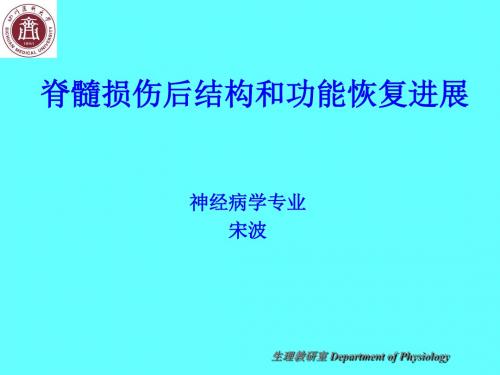
生理教研室 Department of Physiology
2.3、神经保护剂
大剂量甲泼尼龙、钙离子通道阻滞剂、谷氨酸拮 抗剂、一氧化氮合酶抑制剂、抗凋亡药物和炎性 介质调节因子
生理教研室 Department of Physiology
参考文献
1、白波. 2013.神经生物学.南京:江苏科学技术出版社, 139-152 2、李云庆.2010.神经科学基础.第2版.北京:高等教育出版 社,74-89
优点:取材方便、无免疫排斥、无伦理受限、仍 然具有分化为神经元及胶质细胞的潜能——应用 前景广阔 不足:仍然存在潜在致瘤性和移植后生存及突触 再建立难题
生理教研室 Department of Physiology
2、改善细胞生存微环境
2.1消除轴突髓鞘和少突胶质细胞相关的抑制因子 2.2神经营养因子 脑源性神经营养因子(BDNF)、神经营养素3(NT-3)、睫状神经营养因子(CNTF)、成纤维 细胞生长因子(FGF)等
Nogo-A
MAG(髓鞘相关糖蛋白)
OMgp(少突胶质细胞髓鞘糖蛋白
2、星形胶质细胞所形成的瘢痕和其分泌的 相关分子
生理教研室 Department of Physiology
如自由基、NO、花生四烯酸衍生物、TN(细胞外基质
糖蛋白)、CSPG(硫酸软骨素蛋白聚糖家族)
3、异位突触的形成 4、炎性介质的干扰
生理教研室 Department of Physiology
脊髓损伤后的结局
1、神经溃变
顺行性变
逆行性变
跨神经元的变性
2、神经再生
周围神经系统的再生
中枢神经系统的再生
脊髓损伤修复与再生
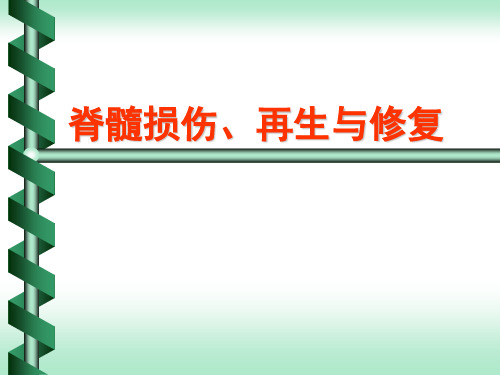
脊髓损伤(spinal cord injury,SCI)基 础研究主要集中在三个方面:
(1)脊髓损伤后脊髓内继发病理改变的预防 和逆转。 (2)脊髓损伤后功能受损但结构完整的神经 细胞功能的恢复。
(3)脊髓损伤后被离断的神经连续性的重建,
即脊髓的再生或脊髓移植。
一、脊髓损伤的组织病理学改变 二、脊髓继发性损伤的机制 三、脊髓损伤后功能检查 四、脊髓损伤模型 五、影响脊髓损伤后神经再生的因素 六、脊髓损伤的内源性保护性因子 七、脊髓损伤的实验性治疗 八、脊髓损伤修复的实验研究
2 .不完全脊髓损伤 : 灰质出血、水肿可 波及白质,但程度较完全损伤为轻,神 经纤维完整,神经细胞不完全退变。 3.轻微脊髓损伤 4 .脊髓压迫损伤 : 脊髓缺血性坏死、囊 腔、软化、纤维化等 5 .脊髓缺血损伤 : 灰质出血,白质坏死, 脊髓软化或纤维化
中度损伤8h T8灰质前角尼氏染色。
6.脊髓横断损伤
(一) 实验性脊髓损伤的病理
1.完全脊髓损伤
病变特点: (1) 病变呈进行性或持续性加重 , 6h内出血累 及全灰质,12h波及白质, (2) 组织代替 : 脊髓坏死组织、退变组织被吞
噬细胞移除并由神经胶质细胞和纤维所代
替; (3) 神经纤维再生 : 近端退变的神经纤维虽可 以再生,但受损伤处增生的胶质组织所制
三、脊髓损伤后功能检查 (一) 脊髓通路检查
1.体感诱发电位 2.运动诱发电位 3.交感性皮肤反应
(二) 周围通路检查
1.肌电图(EMG)和神经图检查 2.反射检查
四、 脊髓损伤模型
理想的模型应符合以下要求:
1.临床相似性: 脊髓损伤模型的制 作过程与临床脊髓损伤过程相近似, 动物的手术制备尽可能少 2.可调控性: 调整损伤强度 3.可重复性
脊髓损伤的再生技术和神经康复

脊髓损伤的再生技术和神经康复脊髓损伤是一种严重的神经系统损伤,常常导致运动、感觉和自主功能障碍。
长期以来,神经科学家们一直在探索各种再生技术和神经康复方法,以帮助患者实现功能的恢复和改善生活质量。
本文将探讨目前关于脊髓损伤的再生技术和神经康复方面的最新研究进展。
一、干细胞治疗脊髓损伤干细胞是一类具有自我更新能力和多向分化潜能的细胞,被视为治疗脊髓损伤的潜在策略之一。
科学家们通过将干细胞移植到受损的脊髓部位,并刺激其分化为神经元或辅助再生组织,试图促进被损伤的神经组织再生。
1. 间充质干细胞近年来,一个备受关注的干细胞类型是间充质干细胞(MSCs)。
这些细胞源于成人组织(如骨髓、脂肪和胎盘),经过体外培养后,可以具备再生潜能。
研究显示,MSCs具有调节免疫反应、促进神经元存活和减少炎症反应等多种功能,这使得它们成为治疗脊髓损伤的理想选择。
2. 胚胎干细胞另一种常用于脊髓损伤治疗的干细胞类型是胚胎干细胞(ESCs)。
这些细胞来自于早期的受精卵,并具有无限分化潜能。
通过将ESC分化为神经前体细胞,并移植到患者的损伤部位,科学家试图促进神经组织再生和功能恢复。
二、基因治疗和基因编辑技术除了干细胞治疗外,基因治疗和基因编辑技术也被广泛应用于脊髓损伤的再生。
通过递送特定的基因或使用CRISPR-Cas9等技术对异常基因进行修复或编辑,可以改善患者受损的神经系统。
1. 神经营养因子基因转移神经营养因子(Neurotrophic factors)是一类促进神经细胞生长和存活的蛋白质,如神经营养因子(NGF)、脑脊液性神经营养因子(BDNF)等。
递送这些基因到损伤区域可以刺激受损神经细胞的再生和修复。
2. 基因编辑技术CRISPR-Cas9技术作为一种高效、准确且简便的基因编辑技术,吸引了大量研究者的关注。
通过CRISPR-Cas9系统精确地删除、修复或替代异常基因,科学家们有望切实改善或治愈部分与脊髓损伤相关的遗传性疾病。
脊髓损伤科学康复流程

脊髓损伤科学康复流程脊髓损伤科学康复流程脊髓损伤是一种严重的神经系统损伤,对患者的身体和生活带来了巨大的影响。
为了帮助患者恢复功能和提高生活质量,脊髓损伤科学康复流程被广泛应用。
这个流程包括了多个阶段,每个阶段都有其特定的目标和方法。
首先是急救和稳定阶段。
在患者刚刚发生脊髓损伤时,急救人员需要迅速采取措施,确保患者的生命体征稳定并防止进一步的损伤。
这可能包括固定脊柱、使用呼吸机辅助呼吸等措施。
接下来是早期康复阶段。
一旦患者的生命体征稳定,康复团队将制定个性化的治疗计划,包括物理治疗、职业治疗和言语治疗等。
物理治疗帮助患者恢复肌肉力量和运动能力,职业治疗则帮助患者重新适应日常生活的各种活动,如穿衣、进食和卫生。
言语治疗主要应用于患有语言和吞咽障碍的患者。
在康复过程中,医疗团队还会提供心理支持和社会支持。
脊髓损伤对患者的心理和社交功能造成了很大的冲击,因此,心理咨询和社会工作等专业人员的帮助至关重要。
他们可以帮助患者应对情绪困扰和社会障碍,帮助他们重新建立自信和适应社会环境。
为了进一步提高康复效果,康复团队还会利用辅助技术和辅助器具。
这些技术和器具包括电动轮椅、义肢和辅助器具,帮助患者恢复行动能力和生活能力。
此外,最新的科学研究还探索了利用神经可塑性和干细胞治疗等新技术,以促进脊髓损伤的康复。
最后是长期康复阶段。
脊髓损伤的康复是一个长期的过程,患者需要在医疗团队的指导下进行长期的康复训练和维护。
这包括定期的体检、康复评估和康复训练,以确保患者的康复进展和生活质量的持续提高。
总的来说,脊髓损伤科学康复流程是一个综合性的康复方案,涵盖了急救、早期康复、心理和社会支持、辅助技术和长期康复等多个方面。
通过全面的治疗和支持,患者可以尽可能地恢复功能,提高生活质量,实现自主生活。
脊髓损伤的康复【85页】
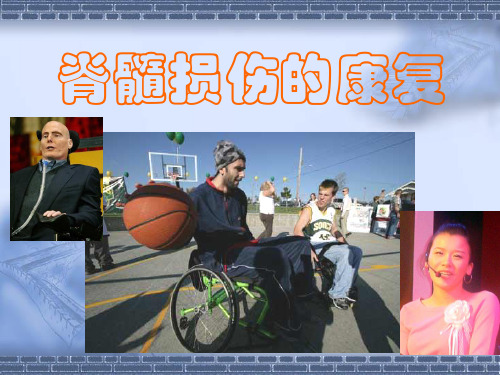
%E?;E?+E?
%E?;E?+E?
%E?;E?+E? ▪ %E?;E?+E? %E?;E?+E? ▪ %E?;E?+E? %E?;E?+E?
椎管内腰骶神经根损伤所致膀胱、肠 道功能障碍及下肢反射消失。
症状可为单侧或不对称;根性疼痛和
感觉障碍位于会阴部\股部或小腿,下肢可有
周围性瘫,括约肌障碍常不明显.
脊髓震荡(spinal concusion )
指暂时性和可逆性脊髓或马尾神经生理功能丧 失,一般认为并没有机械性的压迫,也没有解剖上 的损害。
▪ (4)双肘支撑位下缓慢坐起 目的: ①为病人独立坐起作准备
②提高肩伸肌和肩内收肌、腹肌肌力
▪ (5)帮助下坐起动作 C6以上四肢瘫病人,伸肘肌功能活动丧失,需
他人帮助下才能完成坐起动作。
▪ (6)卧坐转移:坐位姿势则因损伤水平而异 ①下胸部损伤的病人可望达到躯干直立下坐下来 ②下颈部和高位胸椎损伤病人能维持在头前移,躯干屈
3、体温控制障碍:脊髓损伤后,下丘脑不再控制皮 肤血流或出汗水平,这种自主功能障碍导致内源 性体温调节反映的丧失。
4、痉挛:中枢神经系统失去对脊髓的反射弧控制后, 可发生痉挛。痉挛以高张性,高活动性牵拉反射 和阵挛为特征。损伤6个月后逐步增加,受伤后一 年才能相对稳定。多种内外刺激会增加痉挛,包 括姿势改变,皮肤刺激,环境温度,衣服过紧和 情绪变化等。
不全 损伤
完全 损伤
3小时
脊髓损伤康复的研究进展

脊髓损伤康复的研究进展脊髓损伤是一种比较严重的神经系统疾病,一旦发生,往往会带来严重的后果。
其中,严重的脊髓损伤不仅会引起肢体感觉和运动功能的丧失,还常伴随着呼吸、循环和泌尿系统等多方面的问题。
在该领域的研究中,康复是非常重要的一环,下面将简要介绍脊髓损伤康复的研究进展。
一、功能恢复的机制研究1. 转移可塑性理论从神经发育的角度去思考脊髓损伤的康复问题,可以借鉴一些理论成果。
转移可塑性理论强调身体局部组织的功能缺失可以通过其他区域神经系统对其原本不与之相关的功能进行补偿。
因此,许多研究将注意力转向对机体神经结构及功能恢复机制的研究,以更好地促进康复治疗。
2. 神经可塑性理论神经可塑性的概念广泛用于许多功能恢复的研究过程中。
据观察,严重损伤过后的脊髓通常会出现系统性的塑性变化,使其周围的神经元区域再次被激活并产生一些新的功能。
对神经可塑性原理的研究能够帮助人们更好地理解脊髓损伤治疗的过程,同时使得康复治疗参数的选择更为合理科学。
3. 应用生物反馈技术生物反馈技术的应用能够有效提高患者的恢复效率。
该技术通过观测身体的生理信号并将其直观化反馈给患者,让他们更直观地感受到治疗效果,激发其积极治疗情绪,提高康复效率。
这种技术可以更好地帮助患者控制制动、生长和恢复等方面的循环,达到更快的康复效果。
二、功能恢复的方法研究1. 光电刺激技术利用光电刺激技术对神经元进行刺激,可以起到很好的治疗作用。
这种技术可以帮助神经元重新生成,以实现原本丧失的功能的恢复,使患者重新获得运动和感觉能力。
目前,光电刺激技术已经得到广泛的应用,效果很好。
2. 应用电磁治疗技术电磁治疗是一种比较常见的恢复技术,用于加速组织修复和神经元再生,从而促进神经系统的恢复,达到重建功能的目的。
这种技术还可以通过不同频率的电流刺激,帮助神经元获得更高的可塑性,从而更好地恢复受损器官的功能。
3. 应用神经干细胞研究神经干细胞研究的经验表明,其注射效果很好,可以通过其形成的新神经元和系统实现脊髓损伤治疗的恢复。
脊髓损伤康复阶段目标及措施

脊髓损伤康复阶段目标及措施脊髓损伤是一种严重的神经系统损伤,常常会导致肢体瘫痪和功能障碍。
针对脊髓损伤患者的康复工作至关重要,可以帮助患者恢复部分功能,提高生活质量。
在康复阶段,我们需要设定明确的目标,并采取相应的措施,以帮助患者尽快康复。
一、康复阶段目标。
1. 促进神经再生和功能恢复,脊髓损伤后,受损的神经组织需要进行再生和修复,以恢复受损的功能。
因此,促进神经再生和功能恢复是康复阶段的首要目标。
2. 增强肌肉力量和协调能力,脊髓损伤患者常常会出现肌肉萎缩和协调能力下降的情况,因此需要通过康复训练来增强肌肉力量和协调能力,以提高患者的运动功能。
3. 提高日常生活自理能力,脊髓损伤患者常常会面临日常生活自理能力下降的问题,包括如厕、洗漱、进食等方面。
因此,提高患者的日常生活自理能力是康复阶段的重要目标。
4. 促进社会适应能力,脊髓损伤患者在康复期间需要逐渐适应社会生活,包括学习如何使用辅助器具、如何融入社会等方面。
因此,促进患者的社会适应能力也是康复阶段的重要目标。
二、康复阶段措施。
1. 康复训练,针对脊髓损伤患者的具体情况,制定个性化的康复训练方案,包括物理治疗、运动训练、功能训练等,以促进神经再生和功能恢复,增强肌肉力量和协调能力。
2. 辅助器具使用,指导患者学习如何正确使用辅助器具,包括轮椅、助行器、电动助力车等,以提高患者的日常生活自理能力和社会适应能力。
3. 心理支持,脊髓损伤患者常常会面临心理压力和情绪困扰,因此需要给予患者心理支持,帮助其调整心态,积极面对康复过程。
4. 家庭支持,脊髓损伤患者的家庭成员也需要得到支持和指导,以帮助他们更好地照顾患者,促进患者的康复。
5. 康复评估,定期对脊髓损伤患者进行康复评估,及时调整康复方案,确保康复效果。
在脊髓损伤的康复阶段,确立明确的康复目标,并采取相应的措施,可以帮助患者更好地恢复功能,提高生活质量。
同时,也需要患者本人和家庭成员的积极配合和支持,共同努力,才能取得良好的康复效果。
脊髓损伤的康复治疗方案
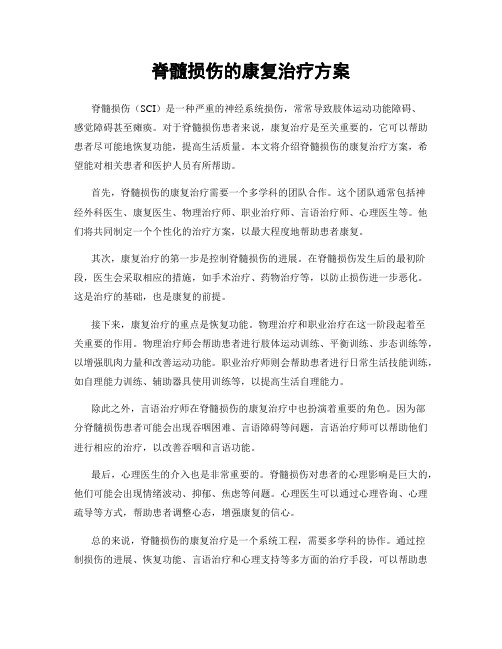
脊髓损伤的康复治疗方案脊髓损伤(SCI)是一种严重的神经系统损伤,常常导致肢体运动功能障碍、感觉障碍甚至瘫痪。
对于脊髓损伤患者来说,康复治疗是至关重要的,它可以帮助患者尽可能地恢复功能,提高生活质量。
本文将介绍脊髓损伤的康复治疗方案,希望能对相关患者和医护人员有所帮助。
首先,脊髓损伤的康复治疗需要一个多学科的团队合作。
这个团队通常包括神经外科医生、康复医生、物理治疗师、职业治疗师、言语治疗师、心理医生等。
他们将共同制定一个个性化的治疗方案,以最大程度地帮助患者康复。
其次,康复治疗的第一步是控制脊髓损伤的进展。
在脊髓损伤发生后的最初阶段,医生会采取相应的措施,如手术治疗、药物治疗等,以防止损伤进一步恶化。
这是治疗的基础,也是康复的前提。
接下来,康复治疗的重点是恢复功能。
物理治疗和职业治疗在这一阶段起着至关重要的作用。
物理治疗师会帮助患者进行肢体运动训练、平衡训练、步态训练等,以增强肌肉力量和改善运动功能。
职业治疗师则会帮助患者进行日常生活技能训练,如自理能力训练、辅助器具使用训练等,以提高生活自理能力。
除此之外,言语治疗师在脊髓损伤的康复治疗中也扮演着重要的角色。
因为部分脊髓损伤患者可能会出现吞咽困难、言语障碍等问题,言语治疗师可以帮助他们进行相应的治疗,以改善吞咽和言语功能。
最后,心理医生的介入也是非常重要的。
脊髓损伤对患者的心理影响是巨大的,他们可能会出现情绪波动、抑郁、焦虑等问题。
心理医生可以通过心理咨询、心理疏导等方式,帮助患者调整心态,增强康复的信心。
总的来说,脊髓损伤的康复治疗是一个系统工程,需要多学科的协作。
通过控制损伤的进展、恢复功能、言语治疗和心理支持等多方面的治疗手段,可以帮助患者尽可能地恢复功能,提高生活质量。
希望脊髓损伤患者能够尽快找到合适的康复治疗团队,获得全面的治疗和帮助。
脊髓损伤的神经重建与功能恢复
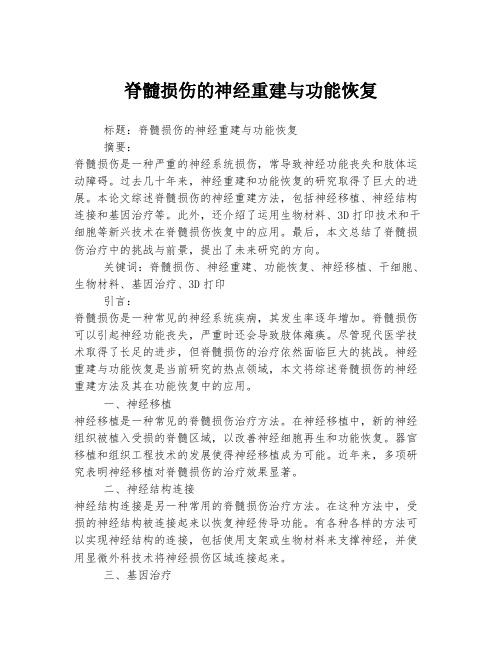
脊髓损伤的神经重建与功能恢复标题:脊髓损伤的神经重建与功能恢复摘要:脊髓损伤是一种严重的神经系统损伤,常导致神经功能丧失和肢体运动障碍。
过去几十年来,神经重建和功能恢复的研究取得了巨大的进展。
本论文综述脊髓损伤的神经重建方法,包括神经移植、神经结构连接和基因治疗等。
此外,还介绍了运用生物材料、3D打印技术和干细胞等新兴技术在脊髓损伤恢复中的应用。
最后,本文总结了脊髓损伤治疗中的挑战与前景,提出了未来研究的方向。
关键词:脊髓损伤、神经重建、功能恢复、神经移植、干细胞、生物材料、基因治疗、3D打印引言:脊髓损伤是一种常见的神经系统疾病,其发生率逐年增加。
脊髓损伤可以引起神经功能丧失,严重时还会导致肢体瘫痪。
尽管现代医学技术取得了长足的进步,但脊髓损伤的治疗依然面临巨大的挑战。
神经重建与功能恢复是当前研究的热点领域,本文将综述脊髓损伤的神经重建方法及其在功能恢复中的应用。
一、神经移植神经移植是一种常见的脊髓损伤治疗方法。
在神经移植中,新的神经组织被植入受损的脊髓区域,以改善神经细胞再生和功能恢复。
器官移植和组织工程技术的发展使得神经移植成为可能。
近年来,多项研究表明神经移植对脊髓损伤的治疗效果显著。
二、神经结构连接神经结构连接是另一种常用的脊髓损伤治疗方法。
在这种方法中,受损的神经结构被连接起来以恢复神经传导功能。
有各种各样的方法可以实现神经结构的连接,包括使用支架或生物材料来支撑神经,并使用显微外科技术将神经损伤区域连接起来。
三、基因治疗基因治疗是一种新兴的脊髓损伤治疗方法。
在基因治疗中,基因被引入受损的脊髓区域,以促进神经细胞再生和功能恢复。
目前,基因治疗已在实验室和临床试验中取得了一些成功的成果。
然而,该方法在临床应用中仍面临许多挑战,如基因传递效率和治疗的长期效果等。
四、生物材料的应用生物材料是近年来在脊髓损伤治疗中广泛应用的一种技术。
生物材料可以用于支撑、修复和再生受损的脊髓组织。
常见的生物材料包括聚合物支架、天然聚合物和仿生材料等。
脊髓损伤的病理生理特点与功能恢复训练

脊髓损伤的病理生理特点与功能恢复训练概述:脊髓损伤是一种重要的神经系统创伤,它对患者的生活质量和功能恢复造成了严重影响。
本文将探讨脊髓损伤的病理生理特点以及功能恢复训练的方法和策略。
一、脊髓损伤的病理生理特点:1. 脊髓解剖结构:脊髓是中枢神经系统的一部分,由灰质和白质组成。
灰质主要包含神经元细胞体,而白质则是由传导纤维构成。
2. 损伤类型:脊髓损伤可分为完全性和不完全性两种类型。
完全性损伤会导致下面完全性瘫痪,而不完全性损伤则有可能保留一定程度的运动或感觉功能。
3. 神经元坏死和再生:脊髓受到损伤后,神经元会发生坏死现象,并且无法再生。
这使得恢复功能变得更加困难。
4. 脊髓反射和运动控制受损:脊髓损伤会影响神经元与肌肉之间的连接。
这导致了脊髓反射和运动控制功能的丧失。
二、功能恢复训练的方法和策略:1. 早期康复治疗:对于脊髓损伤患者来说,早期康复治疗至关重要。
这包括物理治疗、药物治疗和心理咨询等多种手段。
早期的干预可以最大程度地减轻损伤后遗症,促进神经系统的修复和再生。
2. 物理治疗:物理治疗是恢复功能的关键手段之一。
它包括肌肉力量训练、平衡训练和康复运动等。
这些锻炼有助于增强残存神经元的连通性,促进新陈代谢,并帮助患者重新学习日常生活中所需的基本技能。
3. 创新技术应用:随着科技的不断发展,一些创新技术正在应用于脊髓损伤的功能恢复训练中。
例如,电刺激疗法可以通过应用电流刺激神经肌肉连接,促进运动功能的恢复。
另外,脑机接口技术也为脊髓损伤患者提供了一种新的治疗选择。
4. 社会支持与心理咨询:脊髓损伤不仅对身体造成影响,还对心理健康产生明显影响。
因此,社会支持和心理咨询在功能恢复过程中起着重要作用。
提供情感上的支持和帮助患者调整心态是非常必要的。
三、功能恢复训练的挑战:1. 恶化风险:即使尽最大努力进行康复治疗,部分脊髓损伤患者仍然面临功能的进一步丧失和恶化风险。
这可能是因为神经元坏死和再生受到限制,并且其他并发症可能加剧康复过程。
脊髓损伤的康复训练和功能恢复
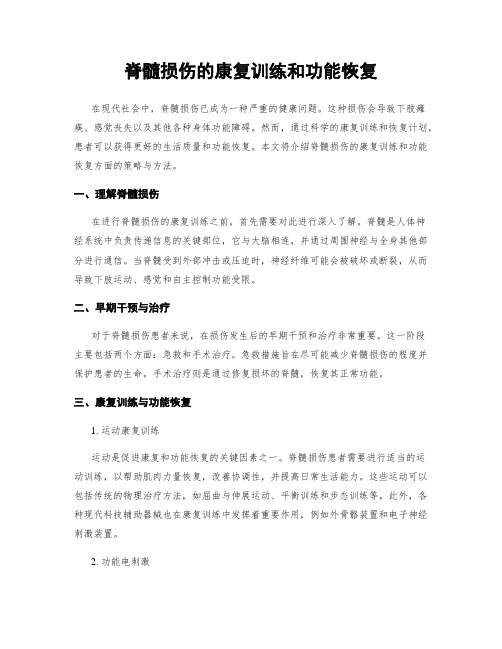
脊髓损伤的康复训练和功能恢复在现代社会中,脊髓损伤已成为一种严重的健康问题。
这种损伤会导致下肢瘫痪、感觉丧失以及其他各种身体功能障碍。
然而,通过科学的康复训练和恢复计划,患者可以获得更好的生活质量和功能恢复。
本文将介绍脊髓损伤的康复训练和功能恢复方面的策略与方法。
一、理解脊髓损伤在进行脊髓损伤的康复训练之前,首先需要对此进行深入了解。
脊髓是人体神经系统中负责传递信息的关键部位,它与大脑相连,并通过周围神经与全身其他部分进行通信。
当脊髓受到外部冲击或压迫时,神经纤维可能会被破坏或断裂,从而导致下肢运动、感觉和自主控制功能受限。
二、早期干预与治疗对于脊髓损伤患者来说,在损伤发生后的早期干预和治疗非常重要。
这一阶段主要包括两个方面:急救和手术治疗。
急救措施旨在尽可能减少脊髓损伤的程度并保护患者的生命。
手术治疗则是通过修复损坏的脊髓,恢复其正常功能。
三、康复训练与功能恢复1. 运动康复训练运动是促进康复和功能恢复的关键因素之一。
脊髓损伤患者需要进行适当的运动训练,以帮助肌肉力量恢复,改善协调性,并提高日常生活能力。
这些运动可以包括传统的物理治疗方法,如屈曲与伸展运动、平衡训练和步态训练等。
此外,各种现代科技辅助器械也在康复训练中发挥着重要作用,例如外骨骼装置和电子神经刺激装置。
2. 功能电刺激功能电刺激是一种通过电刺激来促进肌肉收缩并恢复运动功能的方法。
这种技术通过激活脊髓以下段的神经,以产生肌肉收缩和运动模式。
功能电刺激可以帮助脊髓损伤患者增加主动运动、改善协调性,并促进再学习运动技能。
3. 步行训练与辅助装置对于脊髓损伤造成下肢瘫痪的患者,步行训练是恢复功能的重要一环。
在康复过程中,可以采用不同类型的辅助装置,如助步器、支架或轮椅等,来帮助患者重新学习步行。
逐渐增加步行时间和距离,并结合其他康复训练手段,可以有效提高下肢力量和平衡能力。
4. 感觉恢复训练除了运动功能的恢复外,脊髓损伤后感觉丧失也是一个令人关注的问题。
- 1、下载文档前请自行甄别文档内容的完整性,平台不提供额外的编辑、内容补充、找答案等附加服务。
- 2、"仅部分预览"的文档,不可在线预览部分如存在完整性等问题,可反馈申请退款(可完整预览的文档不适用该条件!)。
- 3、如文档侵犯您的权益,请联系客服反馈,我们会尽快为您处理(人工客服工作时间:9:00-18:30)。
脊髓损伤后脊髓回路及功能的恢复与重组
奥地利帕拉塞尔苏斯医科大学脊髓损伤及组织再生研究中心Dr. Raffaele Nardone研究发现,外伤性脊髓损伤患者电生理可检测出三叉神经- 颈反射和三叉神经-脊髓反射,而在健康对照组人群中未检测到这些相关数据。
此外,正常人群的颈部肌肉的肌电反应的振幅显著高于脊髓损伤的患者。
Dr. Raffaele Nardone认为,这些结果的获得可能涉及三叉神经传入和颈脊髓运动神经元之间的路
径的功能重组。
三叉神经- 颈脊髓反射可用于演示和量化脊髓损伤后脑干和颈水平以下的可塑性变化。
此观点发表在《中国神经再生研究(英文版)》杂志上(2015年10卷2期)。
Article: "Reorganization of spinal neural circuitry and functional recovery after spinal cord injury" by Raffaele Nardone1,2, Eugen Trinka2 (1Department of Neurology, Christian Doppler Klinik, Paracelsus Medical University, Salzburg, Austria; Spinal Cord Injury and Tissue Regeneration Center, Paracelsus Medical University, Salzburg, Austria ; 2Department of Neurology, Franz Tappeiner Hospital, Merano, Italy
Nardone R, Trinka E (2015) Reorganization of spinal neural circuitry and functional recovery after spinal cord injury. Neural Regen Res 10(2):201-202.
欲获更多资讯:
Neural Regen Res
Reorganization of spinal neural circuitry and functional recovery after spinal cord injury The ability of the adult central nervous system to reorganize its circuits over time is the key to understand the functional improvement in subjects with spinal cord injury (SCI). Adaptive changes within spared neuronal circuits may occur at cortical, brainstem, or spinal cord level, both above and below a spinal lesion. The use of electrophysiological techniques to assess these functional changes in neural networks is of great interest, because invasive methodologies as employed in preclinical models can obviously not be used in clinical studies.
Dr. Raffaele Nardone, from Spinal Cord Injury and Tissue Regeneration Center, Paracelsus Medical
University, found that, the TCR and TSR were examined in a group of patients after traumatic
incomplete (ASIA score B, C or D) SCI at cervical level. In healthy subjects reflex responses were registered from the sternocleidomastoid and splenium muscles, while no responses were obtained from upper limb muscles. Conversely, smaller but clear short latency EMG potentials were recorded from deltoid and biceps muscles in about half of the SCI patients. Moreover, the amplitudes of the EMG responses in the neck muscles were significantly higher in the SCI patients. These findings are thought to be the functional correlate of a reorganizational process that involves the pathways between trigeminal afferents and cervical spinal cord motoneurons. This reflex activity is likely to represent an expression of regenerative sprouting of fibers denied their original target populations by the SCI. The anatomical sites at which the trigemino-spinal reflex responses are integrated and propagate up the brainstem and down the spinal cord can be hypothesized on the basis of experimental studies. Since the TCR and TSR appear at the same latencies and share the same cranio-caudal progression as the motor responses involved in the startle reflex, it can been hypothesized that the anatomical neuronal pathways mediating TCR, TSR and startle reflex could be, at least in part, the same. The anatomical substrate for the startle reflex is well established in both animals and humans. A better understanding about the capability of the SCN to reorganize its circuits after injury is a key for developing rehabilitative strategies in persons with SCI. Electrophysiological studies may shed light on the functional mechanisms promoting the rewiring of lesioned motor tracts following SCI. The perspective article is published in Neural Regeneration Research (Vol. 10, No. 2, 2015).
Article: "Reorganization of spinal neural circuitry and functional recovery after spinal cord injury" by Raffaele Nardone1,2, Eugen Trinka2 (1Department of Neurology, Christian Doppler Klinik, Paracelsus Medical University, Salzburg, Austria; Spinal Cord Injury and Tissue Regeneration Center, Paracelsus Medical University, Salzburg, Austria ; 2Department of Neurology, Franz Tappeiner Hospital, Merano, Italy
Nardone R, Trinka E (2015) Reorganization of spinal neural circuitry and functional recovery after spinal cord injury. Neural Regen Res 10(2):201-202.。
